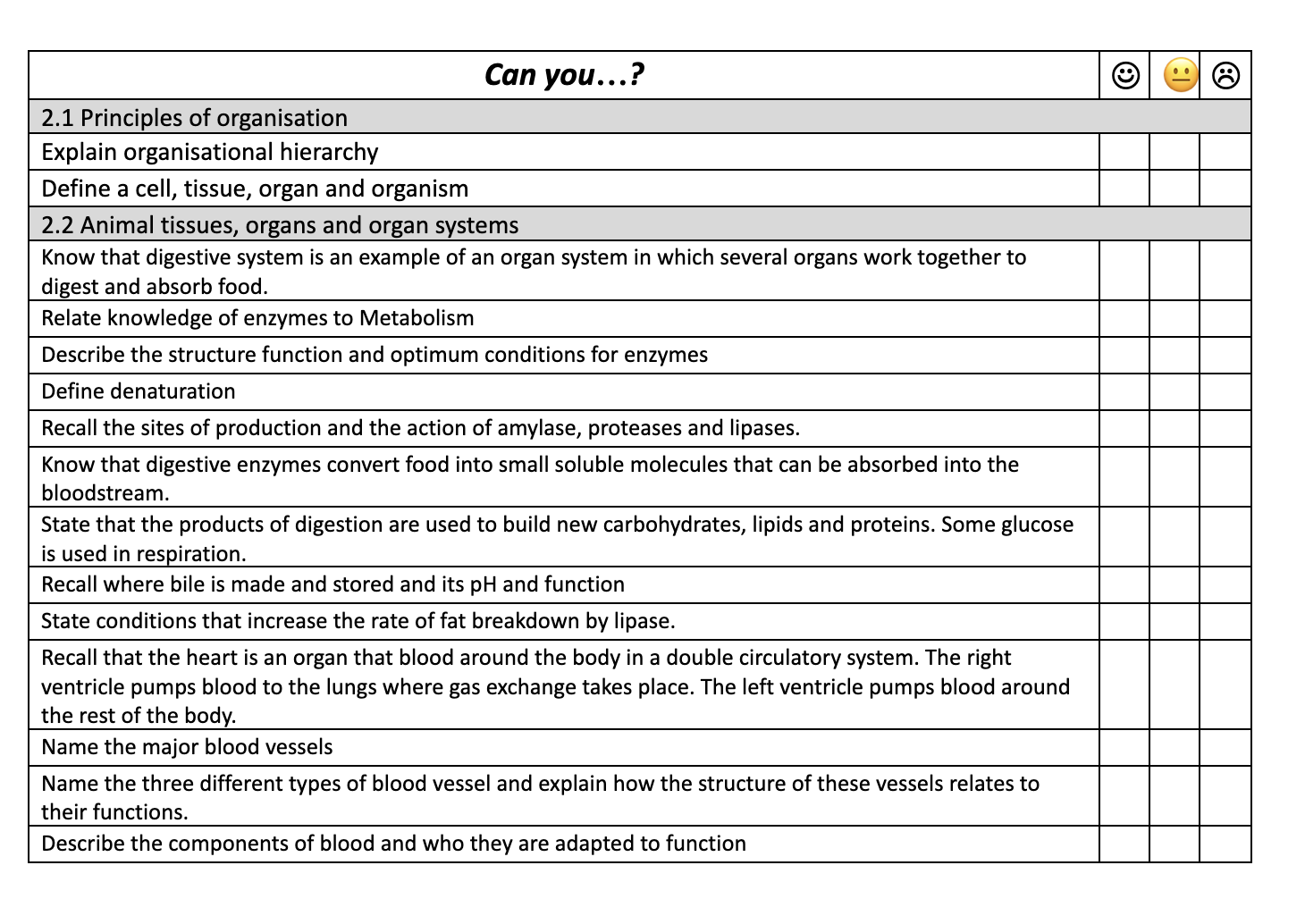Explain organisational hierarchy. Define a cell, tissue, organ and organism. Know that digestive system is an example of an organ system in which several organs work together to di... Explain organisational hierarchy. Define a cell, tissue, organ and organism. Know that digestive system is an example of an organ system in which several organs work together to digest and absorb food. Relate knowledge of enzymes to Metabolism. Describe the structure, function, and optimum conditions for enzymes. Define denaturation. Recall the sites of production and the action of amylase, proteases, and lipases. Know that digestive enzymes convert food into small soluble molecules that can be absorbed into the bloodstream. State that the products of digestion are used to build new carbohydrates, lipids, and proteins. Recall where bile is made and stored and its pH and function. State conditions that increase the rate of fat breakdown by lipase. Recall that the heart is an organ that blood around the body in a double circulatory system. Name the major blood vessels. Name the three different types of blood vessel and explain how the structure of these vessels relates to their functions. Describe the components of blood and who they are adapted to function.

Understand the Problem
The question is asking for various biological concepts such as organisational hierarchy, cell structures, digestive system processes, enzyme functions, and blood vessel types in animals.
Answer
Cells form tissues, tissues form organs, organs form systems, and systems create organisms. The digestive system is an organ system. Enzymes assist metabolism; they're active at specific pH and temperature, but denaturation makes them inactive.
- Organizational hierarchy: Cells form tissues, tissues form organs, organs form systems, and systems form organisms. 2. Cells are the basic structural units; tissues are groups of similar cells; organs are collections of tissues; organisms are complete living systems. 3. The digestive system is an organ system for digestion and absorption. 4. Enzymes catalyze metabolic reactions; their activity requires optimum pH and temperature, and denaturation renders them inactive. 5. Amylase (in saliva), proteases (in stomach and pancreas), and lipases (in pancreas) break down food into soluble molecules. 6. Bile is made in the liver, stored in the gallbladder; it emulsifies fats, functioning best at alkaline pH. 7. Heart pumps blood in a double circulatory system. Arteries, veins, and capillaries are adapted for specific transport roles. 8. Blood components include red blood cells (oxygen transport), white blood cells (immune response), platelets (clotting), and plasma (nutrient transport).
Answer for screen readers
- Organizational hierarchy: Cells form tissues, tissues form organs, organs form systems, and systems form organisms. 2. Cells are the basic structural units; tissues are groups of similar cells; organs are collections of tissues; organisms are complete living systems. 3. The digestive system is an organ system for digestion and absorption. 4. Enzymes catalyze metabolic reactions; their activity requires optimum pH and temperature, and denaturation renders them inactive. 5. Amylase (in saliva), proteases (in stomach and pancreas), and lipases (in pancreas) break down food into soluble molecules. 6. Bile is made in the liver, stored in the gallbladder; it emulsifies fats, functioning best at alkaline pH. 7. Heart pumps blood in a double circulatory system. Arteries, veins, and capillaries are adapted for specific transport roles. 8. Blood components include red blood cells (oxygen transport), white blood cells (immune response), platelets (clotting), and plasma (nutrient transport).
More Information
Cell is the basic unit of life. Tissues, like muscle or nerve tissue, are collections of similar cells. Organs, like the heart, combine different tissues. Organ systems, like the digestive system, are groups of organs that perform complex functions.
Tips
Common mistakes include confusing the sites of enzyme production with their action locations, and misidentifying the levels of organization from cell to organism.
Sources
- Tissues, organs, & organ systems - Khan Academy - khanacademy.org
- Digestive System: Function, Organs & Anatomy - Cleveland Clinic - my.clevelandclinic.org
- 1.2 Structural Organization of the Human Body - open.oregonstate.education
AI-generated content may contain errors. Please verify critical information